 W
WAllochrocebus is a primate genus including the terrestrial guenons: the L'Hoest's monkey, the Preuss's monkey, and the sun-tailed monkey.
 W
WCercopithecini is a tribe of Old World monkey that includes several monkey species, including the vervet monkeys, talapoins, Allen's swamp monkeys and the guenons, all in Africa.
 W
WThollon's red colobus, also known as the Tshuapa red colobus, is a species of red colobus monkey from the Democratic Republic of the Congo and lower Republic of the Congo. It is found south of Congo River and west of Lomami River. It had once been considered a subspecies of the P. badius. It was recognised as a distinct species by Dandelot in 1974, and this was followed by Groves in 2001, while others have suggested it should be considered a subspecies of P. rufomitratus.
 W
WThe Uzungwa red colobus, also known as the Udzungwa red colobus or Iringa red colobus, is a species of primate in the family Cercopithecidae. It is endemic to riverine and montane forest in the Udzungwa Mountains in Tanzania. It is threatened by habitat loss.
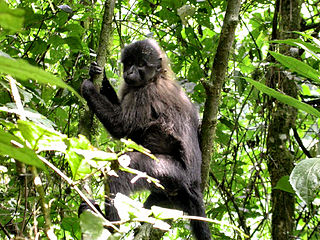 W
WThe crested mangabeys are West African Old World monkeys belonging to the genus Lophocebus. They tend to have dark skin, eyelids that match their facial skin, and crests of hair on their heads. Another genus of mangabeys, Cercocebus, was once thought to be very closely related, so much so that all the species were placed in one genus. However, Lophocebus species are now understood to be more closely related to the baboons in genus Papio, while the Cercocebus species are more closely related to the mandrill. In 2006, the highland mangabey was moved from Lophocebus to a new genus, Rungwecebus.
 W
WThe black-shanked douc is an endangered species of douc found mostly in the forests of eastern Cambodia, with some smaller populations in Vietnam. This species is unique among the doucs in having a largely greyish-blue face. No global population estimate exists, although the Wildlife Conservation Society reports a almost 25,000 individuals present in Cambodia's Keo Seima Wildlife Sanctuary, a population that has remained stable over the last decade. Prior to the discovery of the significance of this population, the largest populations were believed to be in adjacent Vietnam, where the largest known population is around 500-600 individuals. They are primarily arboreal and their diet consists of leaves, from which they obtain most of their water.
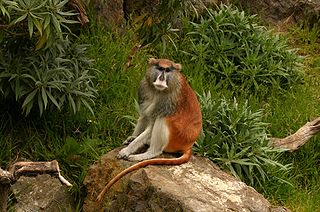 W
WErythrocebus is a genus of Old World monkey. All three species in this genus are found in Africa, and are known as patas monkeys. While previously considered a monotypic genus containing just E. patas, a 2017 review argued that, based on morphological evidence and heavy geographic separation between taxa, E. patas should be split back into distinct species as recognised in the 19th century.
 W
WThe moustached guenon or moustached monkey is a species of primate in the family Cercopithecidae. It is found in Angola, Cameroon, Central African Republic, Republic of the Congo, Democratic Republic of the Congo, Equatorial Guinea, and Gabon.
 W
WThe black-footed gray langur is an Old World monkey, one of the species of langurs. This, like other gray langurs, is a leaf-eating monkey found in south India.
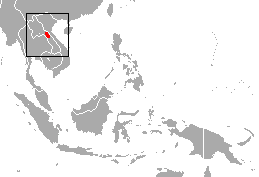 W
WThe Laotian langur or white-browed black langur is a species of primate in the family Cercopithecidae. It is endemic to Laos. Its natural habitat is subtropical or tropical dry forests. Genetically the Indochinese black and Hatinh langurs are very close to the Laotian langur, and consequently it has been suggested they should be considered subspecies of it.
 W
WThe Shortridge's langur is a lutung native to Burma and China.
 W
WThe Thomas's langur is a species of primate in the family Cercopithecidae. It is endemic to northern Sumatra, Indonesia. Its natural habitat is subtropical or tropical dry forests. It is threatened by habitat loss. Its native names are reungkah in Acehnese and kedih in Alas.
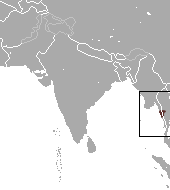 W
WThe Tenasserim lutung is a species of lutung. It is found in Myanmar and Thailand.
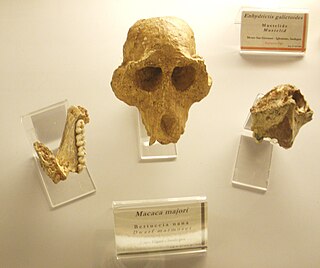 W
WMacaca majori, commonly known as the dwarf macaque, is a prehistoric macaque from the Early Pleistocene of Sardinia, Italy.
 W
WThe Tonkean black macaque or Tonkean macaque is a species of primate in the family Cercopithecidae. It is endemic to central Sulawesi and the nearby Togian Islands in Indonesia. It is threatened by habitat loss. Widespread mining in central Sulawesi is believed to exacerbating the problems of habitat loss.
 W
WThe booted macaque is a macaque of the Sulawesi Island, Indonesia. This Old World monkey is diurnal and spends most of the day in the trees. It is 50–59 cm long plus a tail of 35–40 cm.
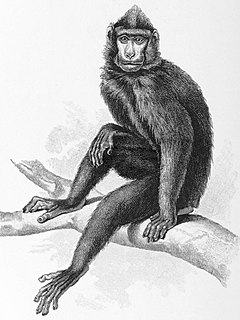 W
WThe Gorontalo macaque or Dumoga-bone macaque is a species of primate in the family Cercopithecidae. It is endemic to the island of Sulawesi in Indonesia.
 W
WThe Heck's macaque is a macaque of Sulawesi, Indonesia. This Old World monkey is diurnal.
 W
WThe moor macaque is a macaque with brown/black body fur with a pale rump patch and pink bare skin on the rump. It is about 50–58.5 cm long, and eats figs, bamboo seeds, buds, sprouts, invertebrates and cereals in tropical rainforests. It is sometimes called "dog-ape" because of its dog-like muzzle, although it is no more closely related to apes than any other Old World monkey is. It is endemic to the island of Sulawesi in Indonesia.
 W
WThe northern pig-tailed macaque is a species of macaque in the family Cercopithecidae. It is found in Bangladesh, Cambodia, China, India, Laos, Myanmar, Thailand, and Vietnam. Traditionally, M. leonina was considered a subspecies of the southern pig-tailed macaque, but is now classified as individual species.
 W
WThe Siberut macaque is a vulnerable species of macaque, which is endemic to Siberut Island in Indonesia. It was formerly considered conspecific with the Pagai Island macaque which is overall paler in color, but this arrangement was polyphyletic. Both were formerly considered subspecies of the southern pig-tailed macaque.
 W
WThe black crested mangabey is a species of primate in the family Cercopithecidae. It is only found in Democratic Republic of the Congo with a small habitat extending to Angola. Its natural habitat is subtropical or tropical dry forests. It is threatened by habitat loss.
 W
WThe golden-bellied mangabey is a social Old World monkey found in swampy, humid forests south of the Congo River in the Democratic Republic of the Congo. It was previously considered a subspecies of the agile mangabey . Little is published about the species and its behaviour has only been studied in captivity.
 W
WThe Mentawai langur is a species of primate in the family Cercopithecidae. It is endemic to the Mentawai Islands in Indonesia.
 W
WMesopithecus is an extinct genus of Old World monkey that lived in Europe and Asia 7 to 5 million years ago. Mesopithecus resembled a modern macaque, with a body length of about 40 centimetres (16 in). It was adapted to both walking and climbing, possessing a slender body with long, muscular limbs and flexible fingers. Its teeth suggest that it primarily ate soft leaves and fruit. It was once thought that these extinct monkeys might be an ancestor of the grey langur, but a more recent study suggests that they are more closely related to the snub-nosed monkeys and doucs.
 W
WDent's mona monkey is an Old World monkey in the family Cercopithecidae found in the Democratic Republic of the Congo, the Congo, Rwanda, western Uganda, and the Central African Republic. It was previously classified as a subspecies of Wolf's mona monkey C. wolf. Verifying whether they are a subspecies or a separate species is dependent on further research that needs to be done at the contact zone of Cercopithecus Denti, Cercopithecus Wolfi, and Cercopithecus Wolfi Elegans, in the forests between the Lualaba and Lomani rivers, south of the junction of the Congo and the Lomani rivers.
 W
WLowe's mona monkey is an Old World monkey in the family Cercopithecidae found from the Ivory Coast to Ghana. It was previously classified as a subspecies of Campbell's mona monkey C. campbelli.
 W
WPapionini is a tribe of Old World monkeys that includes several large monkey species, which include the macaques of North Africa and Asia, as well as the baboons, geladas, mangabeys, kipunji, drills, and mandrills, which are essentially from sub-Saharan Africa. It is typically divided into two subtribes: Macacina for the genus Macaca and its extinct relatives and the Papionina for all other genera.
 W
WParacolobus is an extinct genus of primate closely related to the living colobus monkeys. It lived in eastern Africa in the Pliocene and Early Pleistocene. Fossils have been found in Kenya and Ethiopia, in places such as the Omo valley.
 W
WParadolichopithecus is an extinct genus of cercopithecine monkey once found throughout Eurasia. The type species, P. arvernensis, was a very large monkey, comparable in size to a mandrill. The genus was most closely related to macaques, sharing a very similar cranial morphology. The fossils attributed to Paradolichopithecus are known from the Early Pliocene to the Early Pleistocene of Europe and Asia. The East Asian fossil genus Procynocephalus is considered by some to represent a senior synonym of Paradolichopithecus.
 W
WProcercocebus is a genus of prehistoric baboons closely resembling the forest dwelling mangabeys.
 W
WThe Natuna Island surili is a species of primate in the family Cercopithecidae.
 W
WThe Sarawak surili is a species of primate in the family Cercopithecidae. It is endemic to the southeast Asian island of Borneo, where it is distributed north of the Kapuas River in Kalimantan, Indonesia, the Malaysia states of Sarawak and Sabah, and in Brunei. Its taxonomy is complex and disputed, and it has been considered a subspecies of P. femoralis or P. melalophos. The Sarawak surili was formerly considered common, but has declined drastically due to persecution and habitat loss, and as of 2008 is only known from five sites with a combined population of 200–500 individuals. Consequently, it is believed to be one of the rarest primates in the world, and has been rated as critically endangered by IUCN.
 W
WThe black-crested Sumatran langur is a species of primate in the family Cercopithecidae. It is endemic to Sumatra in Indonesia. Its natural habitat is subtropical or tropical dry forests. It is threatened by habitat loss.
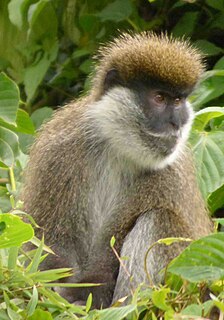 W
WThe Bale Mountains vervet is a terrestrial Old World monkey endemic to Ethiopia, found in the bamboo forests of the Bale Mountains. All species in Chlorocebus were formerly in the genus Cercopithecus. The Bale Mountains vervet is one of the least-known primates in Africa. They avoid tree-dominated and bushland areas as their habitat. These monkeys mainly reside in the bamboo forest of the Bale Mountains due their dietary specialization on bamboo, but other factors, such as climate, forest history, soil quality, and disease, are likely to play a role in their choice to inhabit this area. The Bale Mountains vervet have a very quiet behavior and tend to flee when encountering a human being. It is also known as the Bale monkey.
 W
WThe white-eyelid mangabeys are African Old World monkeys belonging to the genus Cercocebus. They are characterized by their bare upper eyelids, which are lighter than their facial skin colouring, and the uniformly coloured hairs of the fur. The other two genera of mangabeys, Lophocebus and Rungwecebus, were once thought to be very closely related to Cercocebus, so much so that all the species were placed in one genus. However, it is now understood that Lophocebus and Rungwecebus species are more closely related to the baboons in genus Papio, while the Cercocebus species are more closely related to the mandrill.